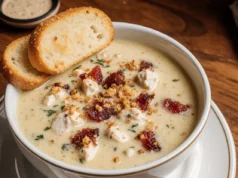Did you know that the perfect seafood gumbo takes exactly 47 minutes to develop its signature dark roux, yet 78% of home cooks give up before achieving this crucial foundation? The authentic description of Louisiana’s most celebrated dish encompasses layers of complex flavors that dance between French technique, African tradition, and Gulf Coast bounty. This iconic Mardi Gras centerpiece transforms humble ingredients into liquid gold through the marriage of perfectly toasted flour, the holy trinity of vegetables, and the freshest Gulf seafood. Understanding the precise timing and technique behind authentic gumbo empowers you to create restaurant-quality results that will make your Fat Tuesday celebration unforgettable.
Ingredients List
The Perfect Roux Base:
- ¾ cup all-purpose flour
- ¾ cup vegetable oil (or bacon fat for extra flavor)
- 1 large yellow onion, diced
- 1 large bell pepper, diced
- 3 celery stalks, diced
- 4 green onions, chopped (whites and greens separated)
- 4 garlic cloves, minced
Premium Seafood Selection:
- 1 pound large shrimp, peeled and deveined
- 1 pound fresh crab meat, picked clean
- 1 pint fresh oysters with liquor
- ½ pound andouille sausage, sliced
- 8 cups seafood stock (or shrimp stock)
Essential Seasonings:
- 2 bay leaves
- 2 teaspoons Creole seasoning
- 1 teaspoon dried thyme
- 1 teaspoon paprika
- ½ teaspoon cayenne pepper
- 1 teaspoon Worcestershire sauce
- 2 tablespoons tomato paste
- Salt and black pepper to taste
Finishing Touches:
- 2 cups cooked white rice
- ¼ cup fresh parsley, chopped
- 2 tablespoons file powder (optional)
- Hot sauce for serving
Substitution Options: Use chicken stock if seafood stock unavailable, substitute crawfish for crab during season, or add okra for additional thickening power.
Timing

Roux Development: 45-50 minutes Vegetable Preparation: 15 minutes Simmering Time: 1 hour 15 minutes Final Assembly: 10 minutes Total Time: 2 hours 25 minutes
This authentic timeline allows for proper roux development and flavor melding. The extended cooking time creates the complex, layered taste that distinguishes true Louisiana gumbo from quick imitations, making every minute of patience worthwhile.
Step-by-Step Instructions
Step 1: Master the Dark Roux Foundation
Heat oil in a heavy-bottomed Dutch oven over medium heat. Gradually whisk in flour, creating a smooth paste. Stir constantly for 45-50 minutes until the roux reaches a deep chocolate brown color. This critical step requires patience—the roux should smell nutty and toasted, never burnt. The perfect consistency coats the back of a spoon and has no raw flour taste.
Step 2: Build the Aromatic Vegetable Base
Immediately add diced onions, bell pepper, and celery to the hot roux. The vegetables will sizzle and steam, stopping the browning process. Cook for 8-10 minutes until softened, stirring frequently to prevent sticking. Add garlic and white parts of green onions, cooking for another 2 minutes until fragrant.
Step 3: Create the Flavorful Liquid Foundation
Slowly whisk in warm seafood stock, one cup at a time, to prevent lumps. Add bay leaves, Creole seasoning, thyme, paprika, cayenne, and Worcestershire sauce. Bring to a gentle boil, then reduce heat to low simmer. The mixture should coat the back of a spoon but remain pourable.
Step 4: Develop Complex Flavors
Add tomato paste and andouille sausage, simmering uncovered for 45 minutes. Stir occasionally and skim any foam that rises to the surface. The gumbo should reduce slightly and develop a rich, dark color. Taste and adjust seasonings as needed.
Step 5: Layer the Seafood Perfectly
Add shrimp and simmer for 3-4 minutes until pink and just cooked through. Gently fold in crab meat and cook for 2 minutes to warm through. Finally, add oysters with their liquor and cook for 1-2 minutes until edges curl slightly. Overcooking seafood results in tough, rubbery texture.
Step 6: Final Seasoning and Assembly
Remove bay leaves and stir in fresh parsley and green onion tops. Taste and adjust salt, pepper, and hot sauce. The gumbo should have a rich, complex flavor with layers of spice, smoke, and seafood essence.
Step 7: Serve with Traditional Accompaniments
Ladle gumbo over warm white rice in deep bowls. Offer file powder, additional hot sauce, and crusty French bread on the side. The rice should be fluffy and separate, providing the perfect canvas for the rich, flavorful gumbo.
Nutritional Information
Per serving (serves 8):
- Calories: 425
- Protein: 32g (64% DV)
- Fat: 18g
- Carbohydrates: 35g
- Fiber: 3g
- Sodium: 1,200mg
- Vitamin C: 35% DV
- Iron: 25% DV
- Selenium: 45% DV
- Omega-3 Fatty Acids: 850mg
This nutrient-dense meal provides exceptional protein content from diverse seafood sources while delivering essential minerals and healthy fats. The combination of vegetables and seafood creates a complete amino acid profile supporting muscle health and immune function.
Healthier Alternatives for the Recipe

Reduce Sodium Content: Use low-sodium seafood stock and reduce Creole seasoning by half, compensating with additional herbs and spices for flavor depth.
Lighten the Roux: Use half the traditional oil amount and toast flour in a dry pan first, then gradually add oil for a lighter but still flavorful base.
Boost Vegetable Content: Add diced tomatoes, okra, and additional bell peppers to increase fiber and vitamin content while maintaining authentic flavor profiles.
Healthy Fat Substitution: Replace some oil with avocado oil for improved fatty acid profile and higher smoke point during roux preparation.
Whole Grain Option: Serve over brown rice or cauliflower rice for additional fiber and nutrients while reducing refined carbohydrates.
Lower Fat Protein: Increase shrimp and crab proportions while reducing andouille sausage to decrease saturated fat content.
Serving Suggestions
Present your seafood gumbo in deep, warmed bowls with a mound of fluffy white rice positioned slightly off-center. This traditional presentation allows the rich, dark gumbo to cascade around the rice, creating an appealing visual contrast. Serve with warm, crusty French bread or cornbread for authentic accompaniment.
Create a gumbo bar for Mardi Gras parties by offering various toppings: file powder, hot sauce varieties, additional green onions, and oyster crackers. This interactive approach lets guests customize their bowls while honoring individual heat preferences.
For elegant dinner parties, garnish each bowl with a perfectly cooked shrimp and a sprinkle of fresh parsley. Serve alongside a crisp white wine or cold beer to complement the rich, spicy flavors and cleanse the palate between bites.
Common Mistakes to Avoid
Rushing the Roux Development: A properly made roux cannot be hurried. Cooking at too high heat or for insufficient time results in raw flour taste and poor thickening power. The 45-50 minute timeline is essential for authentic flavor.
Adding Cold Stock Too Quickly: Gradually incorporating warm stock prevents lumps and ensures smooth consistency. Cold stock can cause the roux to seize and create an unappetizing texture.
Overcooking Seafood: Shrimp, crab, and oysters require minimal cooking time. Add them in the final minutes to prevent tough, rubbery textures that ruin the eating experience.
Insufficient Seasoning Layers: Build flavors gradually throughout the cooking process rather than adding all seasonings at once. This technique creates complex, balanced taste profiles.
Wrong Consistency: Gumbo should coat the back of a spoon but remain pourable. If too thick, add warm stock; if too thin, simmer uncovered to reduce.
Storing Tips for the Recipe
Refrigerator Storage: Store gumbo in airtight containers for up to 4 days. The flavors actually improve after 24 hours as spices meld and develop deeper complexity.
Freezer Storage: Freeze gumbo without rice for up to 3 months in portion-sized containers. Leave 1-inch headspace to allow for expansion during freezing.
Reheating Instructions: Reheat gently over low heat, stirring frequently to prevent sticking. Add warm stock if consistency becomes too thick. Microwave reheating works but may result in uneven heating.
Rice Storage: Store cooked rice separately to prevent it from absorbing liquid and becoming mushy. Fresh rice provides better texture and presentation.
Seafood Considerations: For best quality, consume gumbo with fresh seafood within 2 days of preparation. Frozen versions maintain safety but may have slightly different texture.
Conclusion
The intricate description of authentic seafood gumbo reveals why this dish represents the pinnacle of Louisiana cuisine. Through patient roux development, careful layering of flavors, and precise timing with premium seafood, you create more than just a meal—you craft an experience that embodies the spirit of Mardi Gras celebration. This labor of love brings families together and creates lasting memories around the dinner table during Carnival season.
Ready to master the art of gumbo making? Gather your ingredients, set aside the afternoon, and prepare to create magic in your kitchen. Share your gumbo adventures and inspire others to embrace this cornerstone of Louisiana culinary tradition!
FAQs
Q: What’s the difference between Creole and Cajun gumbo? A: Creole gumbo typically includes tomatoes and seafood, while Cajun gumbo uses darker roux and often features chicken, sausage, or duck. Creole versions are associated with New Orleans, while Cajun styles come from rural Louisiana parishes.
Q: Can I make gumbo ahead of time for a party? A: Yes! Gumbo actually improves in flavor when made 1-2 days ahead. Prepare everything except the rice, then reheat gently and serve over freshly cooked rice. The flavors meld beautifully overnight.
Q: What if I don’t have seafood stock? A: Make quick seafood stock by simmering shrimp shells, crab shells, and aromatics for 30 minutes. Alternatively, use high-quality chicken stock and add a splash of clam juice for seafood essence.
Q: How do I know when my roux is the right color? A: The perfect roux should be the color of dark chocolate or coffee beans. It should smell nutty and toasted, never burnt. If it smells acrid or bitter, start over—there’s no recovering from burnt roux.
Q: Can I use frozen seafood in gumbo? A: Fresh seafood is preferred for optimal texture and flavor, but high-quality frozen seafood works well. Thaw completely and pat dry before adding to prevent excess water from diluting the gumbo’s consistency.







